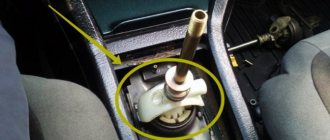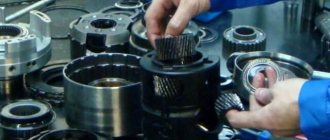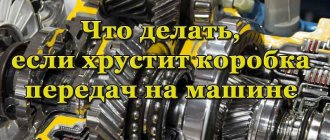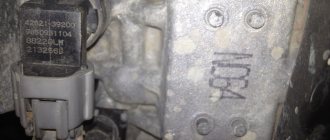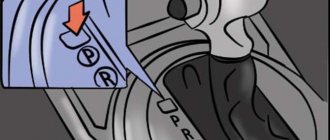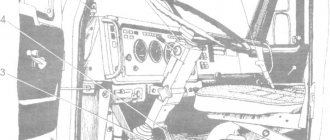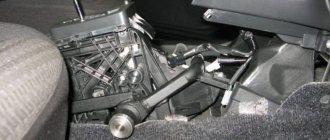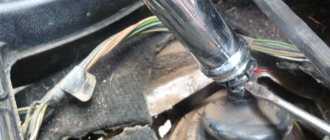One of the main signs of a “deteriorating health” of an automatic transmission, which every owner of a car with an automatic transmission can “feel” is a change in the automatic transmission shifts, the appearance of jolts, jerks or “jerking”.
From this article you will learn:
- Why does the automatic transmission start shifting gears with jerks or jerks?
- Shocks due to cold
- Shocks due to late oil change
- Shocks due to low oil level
- “Non-standard” reasons for automatic transmission jolts
- Is it possible to “cure” automatic transmission kicks?
- Automatic transmission breakdown detection
- I checked all the reasons - it didn’t help
On almost any serviceable modern automatic transmission, the gear shifting process occurs quite quickly and is almost imperceptible to the driver.
Therefore, any changes in automatic transmission switching should cause the owner at least wariness, or better yet, a desire to call in a service center for diagnostics.
The automatic transmission jerks when changing gears, when accelerating, when braking: reasons
First of all, an automatic transmission is a complex unit. In such a box, problems may occur both mechanically and electronically, as well as malfunctions directly related to hydraulic elements. In this case, the main sign of problems is unstable operation of the automatic transmission.
If the automatic transmission jerks when accelerating, when changing gears, during braking, gear shifts are “hard”, gears are engaged untimely, etc., then the transmission needs diagnostics.
First of all, you need to understand why the automatic transmission jerks. Taking into account the fact that there can be many specific breakdowns, we will focus on typical automatic transmission faults.
- Breakdowns or failure of the torque converter (GDT);
- Mechanical wear of automatic transmission parts (gears, clutches, etc.);
- The adjustments are broken (control drive, souring of cables);
- Electrical faults (sensors, ECU malfunctions);
Note that in some cases the automatic transmission may continue to work, while in others the automatic transmission turns on the “emergency” mode, the car is unable to move further, only one gear is engaged, etc.
If the car jerks when shifting (both to a lower and higher gear), the automatic transmission jerks when accelerating and braking, then the automatic transmission often jerks for the following reasons:
- The transmission oil in the box has not warmed up. After the box warms up (after 10-15 km), the problem disappears.
- Increased or decreased level of ATF;
- The oil in the automatic transmission is too dirty, old, and has lost its properties;
- There are problems with the gearbox mounts;
We also note that jerks during acceleration and braking can occur not only due to automatic transmission problems, but also as a result of breakdowns in the car’s chassis and other systems. For example, strong play in the suspension, jamming brakes, worn bearings, etc.
Oil filter
The oil filter performs an important function in an automatic transmission; it accumulates all the contaminants that arise inside. After a certain time, it becomes clogged and liquid can no longer pass through it easily. This provokes a malfunction of the friction discs. They should stop at the right time, but this does not happen due to lack of oil pressure. This is one of the reasons why automatic transmission jerks when changing gears. What to do : along with changing the oil, you need to change the filter. Be sure to purchase a filter in accordance with the brand of the machine.
Common Causes
When the first signs appear, car owners seek answers from experts to the question “why does the automatic transmission jerk in the car?” Experienced service station employees will not immediately determine the cause. It is necessary to test the vehicle for the presence of errors in the ECU or other malfunctions.
Attention! The AL4 (DP0) automatic transmission from the French concern Peugeot-Citroen will always twitch with small, rare vibrations when changing gears. This is a manufacturer's defect that has not been corrected.
Shocks due to late oil change
The lubricant plays a major role in the operation of the automatic transmission. The box will twitch if the car owner:
- does not check the quality of the lubricant. Due to overheating and wear of mechanical parts that mix with the liquid, the oil quickly loses viscosity and does not perform its intended functions. In this case, the automatic transmission will jerk when moving from second to third speed;
- fills in oil from another company that does not meet the standard for the automatic transmission into which it was poured. This happens when a beginner fills in lubricant from another company. Each lubricant is manufactured in accordance with the requirements for certain automatic transmissions.
Attention! The lubricant must be completely replaced after a mileage of 60,000 kilometers and partially after 30 thousand km. Check the lubricant level every ten thousand kilometers.
Automatic transmission jerking will appear when starting in cold weather in the winter season. Cold butter has a thick consistency. It is not capable of becoming plastic in ten seconds. Lubricant will not enter the channels and close and open the valves quickly enough. This means that the torque transmitted by the transmission fluid inside the torque converter will be delayed.
Experts recommend warming up the car and automatic transmission before driving. If there is a sensor on the car dashboard monitor that shows the temperature of the automatic transmission, then it is advisable to wait until it rises to 60 degrees Celsius.
Oil filter
Shocks when switching in an automatic transmission occur due to a dirty filter. This is a device that cleans fluid from wear products of mechanical parts.
Over time, the filter accumulates:
- soot, which contains glue from friction linings;
- chips from wear of metal parts.
It is not capable of passing transmission fluid in the amount that the machine needs for optimal functioning.
Shocks due to low oil level
The machine jerks because the car owner does not check the oil level. Lubricant is produced over time and leaks out in places where there is no tightness in the connections or where the seals dry out. As a result, the lubricant level decreases.
As the ATF level decreases, the pressure in the box drops. Mechanical gears and valves, the operation of which directly depends on the stability of pressure in the hydraulics, slip, jump from one to another and the box jerks.
Friction discs
Friction discs are gears that mesh together using teeth to transmit torque and grip. Over time, the gaps between the disc teeth increase. The larger the gap, the longer it will take for the clutch to engage and start the next gear. If the teeth in one of the clutch packs have become unusable, then the automatic transmission will ignore this speed when changing automatic transmission gears.
The driver usually feels this malfunction as a jolt when the car picks up speed. For example, on a Mazda 6 built before 2009, the driver felt a noticeable jolt when shifting from 3rd to 4th gear. When a Mazda automatic transmission jerks, this indicates wear on the brake band mounting rod on this particular model.
Valve block and valves solenoids
Automatic transmission shocks when switching appear when the valve body solenoids fail. For example, on French automatic models DP0 the oil pressure control valve suffers the most.
The solenoids do not block the channels or, on the contrary, do not open them. The lubricant does not function freely throughout the box. The speeds do not change or do so with a slowdown. The driver feels the machine twitching.
In machines manufactured after 2000, the solenoid housing is made of plastic. Therefore, after a slight overheating of the box in the hot season, the valve solenoids melt and can no longer perform their functions. The gearbox will also jerk.
Electronics
The transmission ECU has the fewest problems. The wires of the electronic control unit break or are torn as a result of mechanical damage. The contacts are oxidized. Signals from the electronic unit are lost and the valves do not open on time or do so with delay.
The driver may notice shocks when switching the automatic transmission if the ECM sensors fail. The electronic control unit of the machine itself rarely breaks down.
Mercedes from the 722.9 series are equipped with seven-speed GMT6T30 automatic transmissions, and on six-speed automatic transmissions of the same model there is an electronic board on the pallet. It's called mechatron. Controls valves with solenoids. The failure of this board can also be signaled to the driver by jerks and jerks of the gearbox.
Liquid cooling radiator
It happens that the automatic transmission only jerks when it’s hot. This indicates that the cooling radiator is not doing its job. As a result, the oil overheats and the lubricant curdles. There is an additional load on the device.
The radiator may not cope with cooling due to the fact that it is clogged with dirt from the outside or inside. Mechanical damage to the pipes and pinches affect the stable circulation of oil through the cooling device.
Other causes of twitching
- When engaging reverse gear, jerking is also observed. Reasons: insufficient warming up or automatic transmission sensor error
- Poor quality fuel and problems with the ignition system can cause jerking.
- Unstable engine operation affects the operation of the automatic transmission. Jerking while driving is a signal that it is necessary to test the operation of the engine.
- Sometimes the cause of jerking is the operation of the adaptive automatic transmission. The transmission adapts to your driving style, and if the automatic transmission jerks, this should not bother you. Over time, the twitching disappears.
- With sudden jumps from a smooth driving rhythm to a sharply high speed, the automatic type of transmission will not cope with the job, in particular the electronics. The ECU does not correctly send a signal to shift gears, so the automatic transmission jerks.
Bottom line: after familiarizing yourself with the causes of breakdowns that cause the automatic transmission to jerk when switching, it is worth drawing conclusions. Particular attention should be paid to the technical condition of the gearbox. With timely automatic transmission diagnostics, minor problems will be identified that can be corrected immediately, otherwise in the future they may develop into larger and more expensive repairs.
Automatic transmission diagnostic methods
Since the operating principle of automatic transmissions with a torque converter is almost identical, the fault detection algorithm is the same for units of all brands and manufacturers:
- systematization of signs of malfunction;
- checking the condition and level of the liquid;
- mandatory check of engine operation at low, medium and high speeds;
- checking for errors in the transmission ECU;
- checking the pressure in the hydraulic system;
- test on a stopped car (Stall Test);
- test while driving (Road Test).
During diagnostics, it is necessary to determine at what point complaints about the operation of the automatic transmission arise - when starting, braking, sharp acceleration or a smooth increase in speed, when engaging an upshift or downshift, at low or high engine crankshaft speeds. Using this algorithm allows you to gradually eliminate the causes of an automatic transmission malfunction until the one you are looking for is determined.
What does it mean when the automatic transmission kicks?
So, car owners are often faced with the fact that various malfunctions of an automatic transmission significantly reduce driving comfort or make further operation of a vehicle with this type of transmission completely impossible.
As a rule, most often a car with an automatic transmission begins to twitch; when changing gears, jerks, jolts, and impacts occur. Less often, gears can be “dragged”, there is a delay in switching, and so-called slipping occurs.
As you can see, in the list of main problems, automatic transmission jolts are the most common. First of all, you need to understand what signs indicate that the automatic transmission is kicking, the automatic transmission is being pushed, etc.
Let us immediately note that in practice, automatic transmission kicks look like this:
- when the selector is moved (for example, from position P to position D or R) to different modes, the driver feels a strong push, impact or jerk that was not there before.
- When driving in different gears (both at the time of upshifting and downshifting), the automatic transmission jerks, kicks, etc. The automatic transmission jolts feel like a light blow to the rear bumper, after which the car sharply moves forward.
Also, the automatic transmission can only push when it’s cold, the automatic transmission kicks when it’s hot or occurs constantly. You can also note that the box can only push in certain gears (for example, when moving from 1st to 2nd, from 3rd to 4th, etc.).
One way or another, such operation of the gearbox indicates problems and the need for automatic transmission diagnostics. In this case, based on one or another indirect signs indicated above, you can try to more accurately determine the nature of the malfunction.
What to do if the reason is ATF
As you can see, the main reason that the automatic transmission jerks when switching is the unsatisfactory condition of the fluid or low temperature. And it doesn’t matter when the automatic transmission starts to twitch: when starting, accelerating, or changing from high to low gear. From here we conclude that if you suspect incorrect operation of the automatic transmission, the first thing you should do is:
- check the fluid level, if it is low, then add it, if it is high, then pump out the excess;
- make sure that the fluid is clean; if there are traces of contamination, replace it as soon as possible;
- when replacing the fluid, be sure to replace the filter, clean the filter mesh, and remove metal particles from the magnetic plugs;
- When driving in low temperatures, remember that the transmission requires warming up for normal operation.
You should also be careful and strictly follow the operating instructions and fill the machine only with the liquid prescribed by the manufacturer. ATF that is not intended for the gearbox that is going to be serviced is guaranteed to damage it.
The main reasons for automatic transmission jerking
Reason in the oil The reason that the automatic transmission jerks may be due to the condition of the oil not meeting the standards or due to low temperature. What to do: when driving in the cold season, you need to understand that for high-quality operation, the gearbox needs additional heating. You need to follow the instructions and use the oil that is designated class=”aligncenter” width=”640″ height=”480″[/img] The liquid is constantly in motion, warming up and cooling, over time the liquid is depleted and becomes unusable. The liquid either thickens or becomes thinner and loses its correct consistency. Shocks and jerks when switching are also present. Excessive oil contamination is an indication that the automatic transmission mechanisms are wearing out. An even greater load on the automatic transmission is the combination of dirty oil and low temperature. Darkening of the oil and the presence of various impurities in it, especially metallic ones, indicate that diagnostics are needed. What to do : you need to change the oil at least every 40 km, and at a maximum every 60 km. Along with the liquid, it is necessary to replace the filter, remove dirt from the filter mesh, and clean the magnetic plugs. Lack and too much fluid leads to foaming. In this case, the automatic transmission pump cannot cope with supplying the required amount of oil to the parts, which leads to their wear. As a result, a jerk is felt when switching the automatic transmission. What to do: Check the amount of fluid more often. Prevent possible leaks and contact qualified technicians only. Important : in city driving conditions, especially in traffic jams, when driving at low speeds, the automatic transmission breaks down faster.
Automatic transmission repair
If there are traces of contamination, completely replace the working fluid in the gearbox. At the same time, change the filter, clean the filter mesh and remove metal particles from the magnetic plugs.
If you notice a malfunction in the autumn-winter period, thoroughly warm up the car every time before driving.
Use only the fluid recommended by the manufacturer.
If the diagnostics do not help to find the automatic transmission problem, check the functionality and condition of the ignition system, radiator, and fuel pump. Problems with the gearbox may be due to low-quality fuel, since the engine and gearbox, as you know, operate in tandem. Experts believe that it is important to carry out a comprehensive diagnosis of the engine compartment, its control system and change the oil. Often the cause of jerking is the adaptive control algorithm of the automatic transmission.
Since the car is a technically verified complex of components and assemblies, for long and safe operation of the vehicle it is necessary to carefully follow all the technical requirements specified in the instructions.
For trouble-free operation of an automatic transmission you need:
1. Use transmission fluid recommended by the manufacturer;
2. Monitor the service interval, promptly change filters and working fluid in the system;
3. At low temperatures, be sure to warm up the gearbox before driving, check the oil pressure and fluid level in the system.
Qualified employees of official FAVORIT MOTORS service centers provide high-quality diagnostics, repairs and routine maintenance of vehicles, including vehicles equipped with an automatic transmission. All work is carried out on time, using high-quality equipment, original spare parts and consumables. Service masters are professionals who have been trained in specialized training centers of car manufacturers of various brands.
Overheat
A properly functioning cooling system is an important component of the health of the machine. Jerking of the box can be caused by simple overheating of the working fluid. This happens, for example, when pushing for a long time in traffic jams in the heat, when, in addition, the cooling radiators are clogged or the thermostat of the transmission cooling system is stuck in the closed position. The first case often occurs, for example, on the penultimate generation Ford Mondeo with a 6-speed Aisin automatic transmission, and the second on BMW models with a ZF 6HP unit.
Engine sensors
Jerking of the machine can be caused by malfunctions of individual sensors of the engine control system. For example, a mass air flow sensor or a throttle position sensor. At the same time, sometimes the Check Engine lamp does not even light up and no errors are recorded in the memory. And if they exist, then they indicate a malfunction of some elements of the machine, which are actually in perfect order.
A real example of such a development of events from the experience of servicemen is the penultimate generation Ford Mondeo mentioned above. Its 6-speed Aisin automatic transmission may jerk due to a faulty EGR (exhaust gas recirculation) valve, which affects the change in engine torque (the transmission control unit uses it to calculate shifts).
Control block
A faulty transmission control unit is another possible culprit for shock switching of the machine. Structurally, it can be either an independent unit or a built-in unit of the “brains” of the engine. For example, on the second generation Mazda 6, a separate automatic transmission unit is installed in the vehicle interior. For diagnostics, you can substitute a known-good module from another machine of a similar modification. The replacement procedure does not require block programming, has no pitfalls and immediately eliminates a lot of questions.
Why does the automatic transmission jerk?
An automatic transmission consists of dozens of mechanisms that must work harmoniously so that gears shift smoothly and on time. There are several variations of automatic transmission, and each unit developer tries to make their own improvements to it. In this case, we can name typical malfunctions for all automatic transmissions:
- Failure or incorrect operation of the torque converter;
- Mechanically worn gearbox parts;
- Broken adjustments, including the control drive;
- Cable souring;
- Problems with the electrical component;
- Incorrect operation of the electronic control unit;
- Wear of friction clutches.
However, many of the above faults can cause complete failure of the automatic transmission. If the car jerks when the automatic transmission is switched to an up or down gear, and jerks are noticeable when accelerating or decreasing speed, the range of problems can be significantly reduced. Most often, the machine jerks during operation due to the following malfunctions:
- The car is not warmed up well, in which case the problem should disappear as the trip progresses;
- Lack or excess of transmission fluid (ATF);
- The transmission fluid is unsuitable for use (contaminated);
- Worn gearbox mounts;
- The chassis of the car is faulty and there are gaps in it.
Most often, problems in the gearbox arise precisely because of the inattention of drivers who do not monitor the level of transmission fluid. It is important that there is enough of it in the gearbox, but not excessive. If you put too much ATF into the transmission, it will begin to foam because the pump cannot handle the volume available. In a situation where there is not enough transmission fluid in the gearbox, the mechanical wear of its elements increases. This is especially dangerous when operating a car in a city, where traffic lights, traffic jams and other road users regularly force the engine to operate at low speeds, which is a stressful situation for the transmission.
The machine jerks: what to do
In most cases, automatic transmission problems occur due to transmission fluid when drivers do not monitor its level and condition. Therefore, before contacting a transmission diagnostic service, you can try to fix the problem yourself as follows:
- Check the transmission fluid level. If it is not enough, you will need to add a new one or make a complete replacement. If there is a lot of liquid, you need to pump out the excess;
- Check the condition of the fluid. To do this, you can drop a little of it onto a white napkin and determine the degree of contamination. If the fluid is dark, it needs to be replaced. When metal “crumbs” are visible in it, this is a clear sign that the parts of the automatic transmission are mechanically wearing out and it requires urgent inspection by specialists;
- If the transmission fluid is being replaced, it must be remembered that the maximum effect will be achieved only in conjunction with replacing the filter and cleaning the magnetic plugs from metal parts that have fallen on them.
Article on the topic: How to check a ball joint and determine the malfunction
Important: The automatic transmission must be filled with transmission fluid recommended by the vehicle manufacturer. Incorrect selection of fluid can lead to rapid transmission failure and costly repairs.
How to diagnose the cause of an automatic transmission malfunction
It is quite difficult to independently determine the reason why the automatic transmission jerks when changing gears. It is better to leave the work of diagnosing the fault to service center specialists, who will check the car with diagnostic instruments and, based on the results obtained, make their verdict. To determine the cause of an automatic transmission malfunction, technicians look at the following indicators:
- Error codes in the electronic control unit;
- “Behavior” of the gearbox during the Stall test (diagnostics on a stopped vehicle) and Road test (diagnostics in motion);
- Pressure in the hydraulic system;
- Stability of engine and gearbox operation at low, medium and high speeds.
When diagnosing a gearbox, specialists determine the range of main faults that could affect the stability of its operation.
Shocks due to late oil change
The second most common cause of jerks when switching automatic transmissions is dirty oil. When the transmission fluid is contaminated above a certain limit, its physical properties begin to change, which can lead to “jerking” when shifting gears.
Constant operation of the automatic transmission on dirty oil also leads to overload of certain elements of the box, which can lead to serious damage. That is why each automatic transmission has its own scheduled oil change periods, which can be reduced under difficult operating conditions.
Separately, it is worth noting the operation of the machine on dirty oil at low temperatures. Under these conditions, the box experiences longer overloads, since dirty oil loses the necessary physical properties noticeably earlier than clean oil, which shortens the service life of the automatic transmission. To prevent the automatic transmission from operating with “maximum” overloads - due to dirty oil and at low temperatures - many car owners prefer to change the oil and filter in the automatic machine in the fall, preparing the box in advance for use in cold weather.
The automatic transmission jerks when accelerating (accelerating)
The main symptom of such an automatic transmission problem is the presence of jerks and fairly strong impacts during gear shifting while accelerating the car. When the machine operates in manual mode, the picture of the malfunction remains the same. Corrective measures:
- Changing transmission oil.
- Replacing the fuel system filter.
- Monitor the position of the gear shift inhibitor and adjust if necessary. If the symptoms of the malfunction persist, the inhibitor is replaced simultaneously with the (additional) mounting plate.
- Monitoring and subsequent adjustment of the transmission oil level.
What and why to slow down?
Let's start with a theoretical excursion into the mechanical-hydraulic jungle of automatic transmissions. It will be a little boring, but not for long.
So, all automatic transmissions have several common large components. The first of them is a torque converter, which replaces the automatic clutch of a manual transmission. He is also the GDT, he is also the “donut”. The torque converter received its second name, as you already understood, due to its external similarity to this edible flour product. There is a turbine wheel, a pump wheel and a reactor. And butter. The task of the gas turbine engine is to transmit rotation from the engine flywheel to the planetary gear shaft.
A planetary gear is a set of gears of different gears. In general, it is also similar to conventional mechanics: the combination of gears changes - the gear ratio changes (gears change, just like in a manual transmission). To change gears you need a set of clutches and brake mechanisms.
There is also a control device - a hydraulic unit. If you've ever heard that an automatic transmission has solenoids that switch something, then let's reveal a secret: they are located in the valve body, and the task of these valves (which are often called solenoids) is to redistribute the flow of ATF (transmission fluid) for engaging the desired gears in accordance with signals from sensors and other electronics processed in the automatic control unit.
Articles / Practice The crisis of hydromechanics: why new automatic transmissions are as unreliable as “robots” and CVTs Until recently, the problems of DSG preselective gearboxes were on everyone’s lips, and an alternative hydromechanical gearbox on VW and Skoda cars was considered by many as a real solution to the problem… 97560 27 78 05.11.2015
The planetary gearboxes of automatic transmissions have friction discs. They can be in an open state (in which case they rotate freely) or closed to transmit torque to the sun gear of a planetary gearbox (as you know, in a planetary gearbox the gears are inserted into each other). The clutches engage the transmission gears in a certain sequence. When they wear out, the gears may stop engaging altogether, and jerking and slipping may occur at the time of shifting. In fact, wear of the clutches is the most common automatic transmission malfunction. But we won’t be distracted by this for now.
The clutches are collected in packages, which are often called drums. Nowadays, drums are often divided into two categories - clutch and braking. The first ones are needed for what was described above - to transmit rotation from one shaft to another.
But the brake drum is needed just to brake one of the elements of the planetary mechanism in order to select the correct combination of gear clutches at the moment of gear shifting. Braking package clutches are already a common thing, although it appeared not so long ago, along with the introduction of the ability to adjust the braking force using proportional solenoids PWM, VBS or VFS.
In simpler boxes at the turn of 1990-2000 there were ordinary solenoids that had only two positions. They are called on/off solenoids. They do not have the ability to adjust the force, and in such boxes, instead of a package of braking clutches, they installed ordinary brake bands, which, covering the drum from above, could stop it. For most modest four-speed automatic transmissions, such a mechanism was sufficient: it is simpler and more reliable, although in terms of “intelligence” it does not reach the brake drum.
Let's reveal a secret: during the diagnostic process, we found out that the cause of the “kicks” when switching the automatic transmission (the Focus has a Ford 4F27E gearbox) was precisely the wear of the Overdrive brake band. Therefore, today we will focus on replacing it.
Articles / Practice “Donut”, automatic transmission killer: what breaks in torque converters and how they are repaired The torque converter, also known as the “donut” (the nickname comes from its shape), is an indispensable attribute of any “real automatic”. Powerful CVTs cannot do without it, and even in preselective ones... 166881 5 33 03/19/2015
Wear of the belt leads to the fact that switching from first to second and from third to fourth gear is accompanied by jerks, jolts, and in advanced cases it becomes completely impossible. Why these particular programs? This is going to be a little difficult now.
To engage third gear, the 3-4 package is clamped and the brake band releases the drum. That is, belt wear does not affect the engagement of third gear in any way.
But when you engage second gear, the brake band brakes the Reverse drum holder on the automatic transmission housing and locks the sun gear of the rear planetary gear. If the belt is worn out, the braking of the drum is delayed, which causes slipping and shock.
When engaging fourth gear, the sun gear of the same rear planetary gear is locked with a tape in the same way.
Well, when the first gear is in operation, the Reverse drum generally rotates in the opposite direction and the belt, of course, does not press it. So the belt wear is noticeable only when switching to second or fourth gear.
Now it's time to move on to the practical part: disassemble the box a little and change the tape. But first, let us remind you where you could find the 4F27E automatic transmission (for Mazda this gearbox was called FN4A-EL). The list of cars with these automatic machines is extensive; we will name only the most popular cars in our country. These are Ford Fiesta (2008-2011), Focus/Focus C-Max (2000-2011), Mazda 2 (2007-2011), 3 (2004-2011), 323 (2000-2007), 6 (2002-2008), Atenza/5HB/Wagon (2002-2005), Demio (2000-2011), Familia (2000-2005), MPV (2000-2007), Premacy (2000-2010), Tribute (2003-2008). This list is incomplete, but it makes it clear that the 4F27E is rightfully considered the most popular automatic transmission in Ford and Mazda. And, perhaps, the most convenient for repair: it can be disassembled without removing it from the car.
Sources
- https://KrutiMotor.ru/dergaetsya-korobka-avtomat-prichiny/
- https://akppoff.ru/korobka-avtomat/pri-pereklyuchenii-peredach-mashina-dergaetsya-akpp
- https://autolirika.ru/remont/kogda-i-pochemu-avtomat-dergaetsya.html
- https://favorit-motors.ru/articles/obsluzhivanie-i-remont/dergaetsya-korobka-avtomat/
- https://www.zr.ru/content/articles/915081-10-prichin-pochemu-avtomat-der/
- https://auto-self.ru/dergaet-avtomat-pri-pereklyuchenii-peredach-prichiny-chto-delat/
- https://VipWash.ru/korobka-peredach/korobka-avtomat-dergaetsya-pri-pereklyuchenii
- https://www.kolesa.ru/article/sdelaj-mne-plavno-kak-otuchit-akpp-pinatsya-bystro-i-nedorogo

